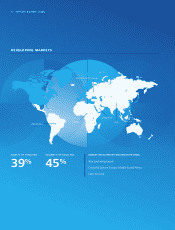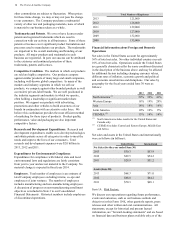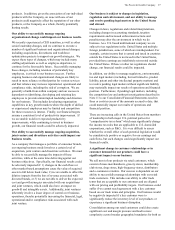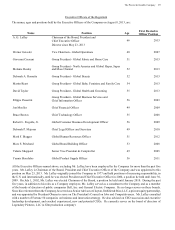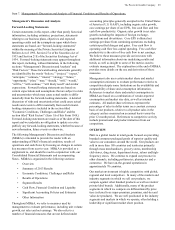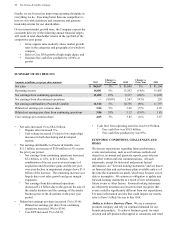Proctor and Gamble 2013 Annual Report Download - page 19
Download and view the complete annual report
Please find page 19 of the 2013 Proctor and Gamble annual report below. You can navigate through the pages in the report by either clicking on the pages listed below, or by using the keyword search tool below to find specific information within the annual report.The Procter & Gamble Company 17
products. In addition, given the association of our individual
products with the Company, an issue with one of our
products could negatively affect the reputation of our other
products, or the Company as a whole, thereby potentially
hurting results.
Our ability to successfully manage ongoing
organizational change could impact our business results.
We recently experienced a CEO transition, as well as other
senior leadership changes, and we continue to execute a
number of significant business and organizational changes,
including acquisitions, divestitures and workforce
optimization projects to support our growth strategies. We
expect these types of changes, which may include many
staffing adjustments as well as employee departures, to
continue for the foreseeable future. Successfully managing
these changes, including retention of particularly key
employees, is critical to our business success. Further,
ongoing business and organizational changes are likely to
result in more reliance on third parties for various services
and that reliance may increase reputational, operational and
compliance risks, including the risk of corruption. We are
generally a build-from-within company and our success is
dependent on identifying, developing and retaining key
employees to provide uninterrupted leadership and direction
for our business. This includes developing organization
capabilities in key growth markets where the depth of skilled
or experienced employees may be limited and competition
for these resources is intense. Finally, our financial targets
assume a consistent level of productivity improvement. If
we are unable to deliver expected productivity
improvements, while continuing to invest in business
growth, our financial results could be adversely impacted.
Our ability to successfully manage ongoing acquisition,
joint venture and divestiture activities could impact our
business results.
As a company that manages a portfolio of consumer brands,
our ongoing business model involves a certain level of
acquisition, joint venture and divestiture activities. We must
be able to successfully manage the impacts of these
activities, while at the same time delivering against our
business objectives. Specifically, our financial results could
be adversely impacted if: 1) changes in the cash flows or
other market-based assumptions cause the value of acquired
assets to fall below book value, 2) we are unable to offset the
dilutive impacts from the loss of revenue associated with
divested brands, or 3) we are not able to deliver the expected
cost and growth synergies associated with our acquisitions
and joint ventures, which could also have an impact on
goodwill and intangible assets. Additionally, joint ventures
inherently involve a lesser degree of control over business
operations, thereby potentially increasing the financial, legal,
operational and/or compliance risks associated with each
joint venture.
Our business is subject to changes in legislation,
regulation and enforcement, and our ability to manage
and resolve pending legal matters in the United States
and abroad.
Changes in laws, regulations and related interpretations,
including changes in accounting standards, taxation
requirements and increased enforcement actions and
penalties may alter the environment in which we do
business. As a U.S. based multinational company we are
subject to tax regulations in the United States and multiple
foreign jurisdictions, some of which are interdependent. For
example, certain income that is earned and taxed in countries
outside the United States is not taxed in the United States,
provided those earnings are indefinitely reinvested outside
the United States. If these or other tax regulations should
change, our financial results could be impacted.
In addition, our ability to manage regulatory, environmental,
tax and legal matters (including, but not limited to, product
liability, patent and other intellectual property matters) and
to resolve pending legal matters without significant liability
may materially impact our results of operations and financial
position. Furthermore, if pending legal matters, including
the competition law and antitrust investigations described in
Note 11 to our Consolidated Financial Statements result in
fines or costs in excess of the amounts accrued to date, that
could materially impact our results of operations and
financial position.
There are increasing calls in the United States from members
of leadership in both major U.S. political parties for
“comprehensive tax reform” which may significantly change
the income tax rules that are applicable to U.S. domiciled
corporations, such as P&G. It is very difficult to assess
whether the overall effect of such potential legislation would
be cumulatively positive or negative for our earnings and
cash flows, but such changes could significantly impact our
financial results.
A significant change in customer relationships or in
customer demand for our products could have a
significant impact on our business.
We sell most of our products via retail customers, which
consist of mass merchandisers, grocery stores, membership
club stores, drug stores, high-frequency stores, distributors
and e-commerce retailers. Our success is dependent on our
ability to successfully manage relationships with our retail
trade customers. This includes our ability to offer trade
terms that are acceptable to our customers and are aligned
with our pricing and profitability targets. Our business could
suffer if we cannot reach agreement with a key customer
based on our trade terms and principles. Our business would
be negatively impacted if a key customer were to
significantly reduce the inventory level of our products or
experience a significant business disruption.
Consolidation among our retail customers could also create
significant cost and margin pressure and lead to more
complexity across broader geographic boundaries for both us





